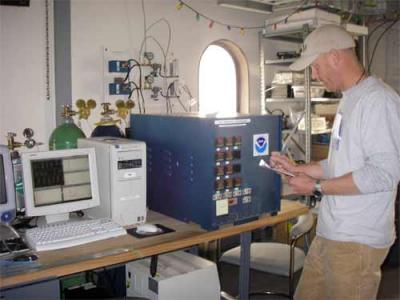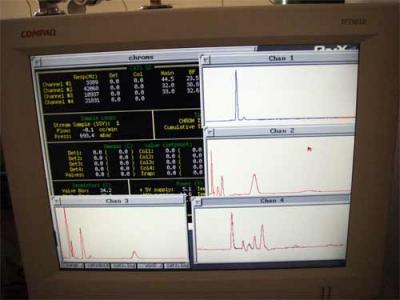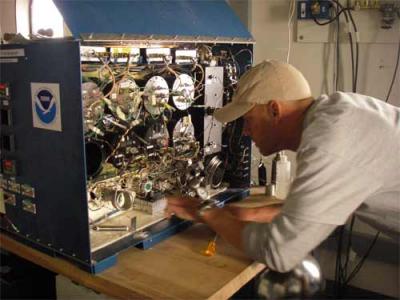Detecting CFC’s and their replacements at the South Pole
Temperature: minus 24.9.5 C, minus 12.8 F Windchill: minus 33.6 C, minus 28.4 F Wind: 6 knots. Weather: bright and sunny in the morning, then increasing cloudy with little visibility
I did not want to confuse topics in the previous journal, so I decided to write two parts for one day. In part 2 of December 17 I would like to cover what Andy taught me a few days ago: How we detect CFC’s in the Antarctic atmosphere.
First some background information: CFC’s are the pollutants that destroy our ozone layer. Scientists discovered CFC’s as a useful coolant in the 40ties. Ever since, we have been able to enjoy refrigeration, air-conditioning, spray cans, cleaning agents, to name only a few.
Imagine life without ice cream in your freezer!
These coolants were harmless for us in the troposphere. However, we were not aware that these pollutants made their way up to the stratosphere over the following 30 years, to the part of the atmosphere were the ozone layer is located. The chlorine of the CFC that has been frozen over the Antarctic winter onto the Polar Stratospheric clouds (PSC) , circled around the Antarctic continent in a very stable cold winter air mass called the vortex. Every August, with the rise of the sun during the Antarctic spring time, the chlorine is set free by the PSC and starts to react with the ozone and depleting it. We call this the formation of the Antarctic ozone hole! The ozone hole is monitored very carefully with many balloon flights by the NOAA team during the month of august, September, October, and the beginning of November. We discovered the ozone hole in the seventies, with the help of the data collected at the South Pole. In 1987, the Montreal Protocol was signed by many countries, including the USA. The Montreal Protocol banned the CFC’s used by all industrial countries.
These were some of the CFC pollutant that were banned by the Montreal protocol and are still monitored at ARO: the propellant CFC-11 used in hair sprays and in foam productions, CFC -12 used in old air-conditioners, and the industrial solvents: CH3CCl3, and CCl.
Gases in the air can be detected with a gas-chromatograph. ARO has a gas-chromatograph that is monitored carefully by Andy during his time at the pole.
 Andy is standing next to the gas-chromatograph conducting the daily checks. This gas- chromatograph tests the concentration of CFCs and the replacement CFC’s.*
Andy is standing next to the gas-chromatograph conducting the daily checks. This gas- chromatograph tests the concentration of CFCs and the replacement CFC’s.*
 A typical diagrams that can be observed while the gas-chromatograph is running.*
A typical diagrams that can be observed while the gas-chromatograph is running.*
 Technicians like Andy need to be able to fix this machine in remote areas like the South Pole or Greenland.*
Technicians like Andy need to be able to fix this machine in remote areas like the South Pole or Greenland.*
The NOAA team detected the decline of the CFC’s in the atmosphere, the gases that destroy the ozone layer. However, countries like China and India are still allowed using these cheaper coolants.
Some of the replacement gases monitored at ARO are: HCFC-22 used in new home air-conditioners and HCFC-141b and 142b , propellants, and HFC- 134a, used now in car air-conditioners. These replacement gases do not harm the ozone layer anymore, however, they are green house gases and warm our atmosphere. So, we still have to try reducing the use of air-conditioners!!
The main green house gas is carbon dioxide, the gas that is produced by burning fossil fuels. Carbon dioxide is also monitored by the NOAA team. (See journal December 15, 2007). Green-house gases warm our atmosphere which can cause climate changes. The warming of the atmosphere can melt the polar ice and raise the water of the sea-level. The NOAA instruments show that the amount of green house gases in the atmosphere is still rising. We all need to help to reduce the use of energy and therefore the production of more greenhouse gases wherever and whenever we can!! We can start by simply reducing, recycling and reusing a lot of our recourses, like paper, cans, metals, and plastics.
For more information about the Global Monitoring Division, the NOAA group I am working with, and their monitoring work of CFC’s, CO2, ozone depletion, water vapor and radiation, go to the NOAA web page: www.esrl.noaa.gov

